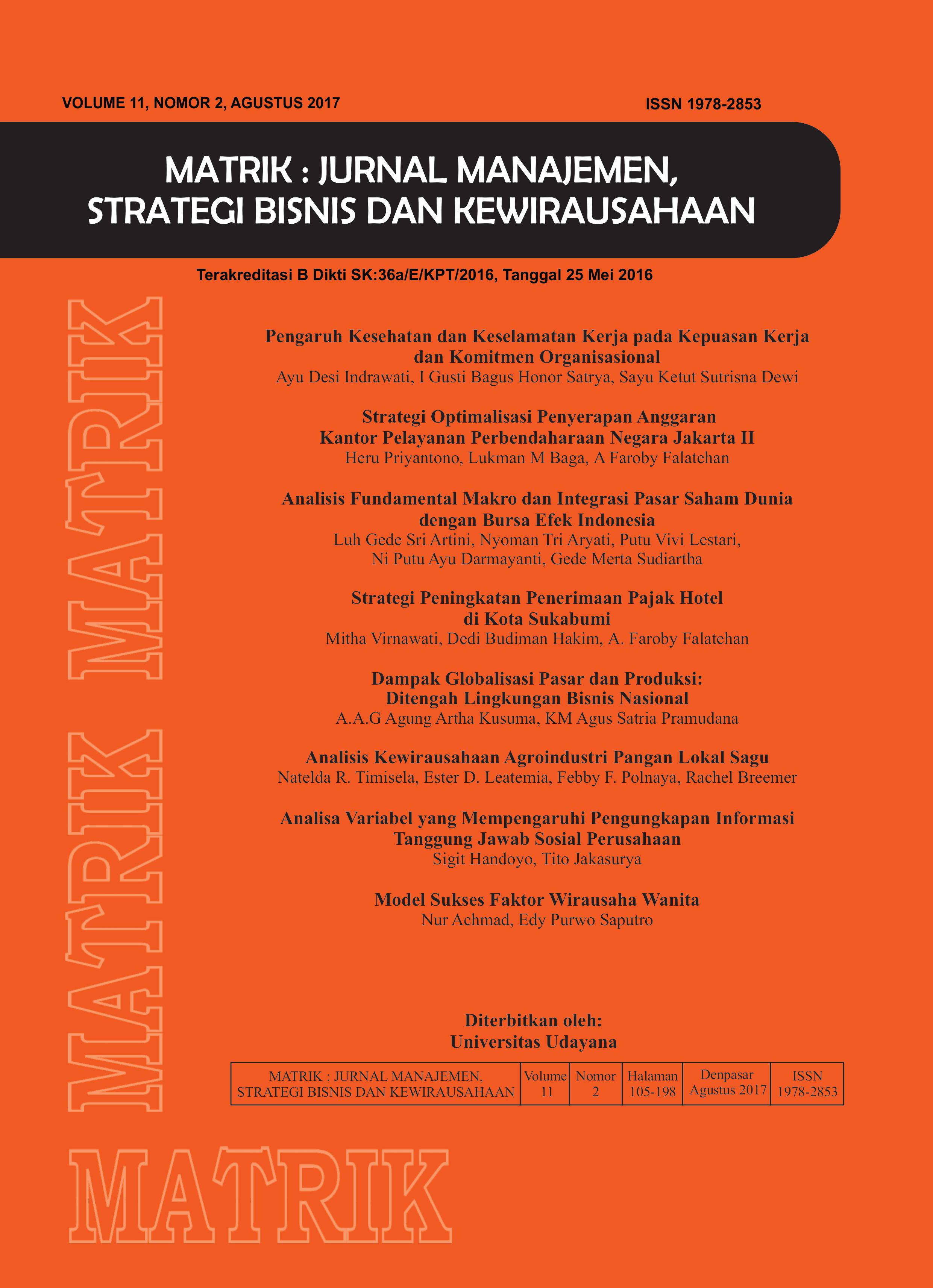DAMPAK GLOBALISASI PASAR DAN PRODUKSI: DITENGAH LINGKUNGAN BISNIS NASIONAL
Abstract
A fundamental shift has happened in the economics and business world. Countries within the same region integrates one another consolidating their politics and economies creating a trading bloc as means for accelerating economic growth. This situation creates new market opportunities and access for low cost workers for producers, consequently generating multiple country of origin information in a single product. For consumers, in terms of evaluating a product, currently are experiencing a new shift, cognitively consumers separate the cue signaled from both country of design and country of manufacture. In this study, first is analysed the impact of strong image related concept that presents with fashion products toward purchase intention, from the test, result is concluded that perceived quality, brand awareness, and fashion involvement had positive correlation toward purchase intention. Second is analysed the role of both country of origin and consumer ethnocentrism that serve as the weak country image concept in moderating function, the outcome form the test concluded that country of origin and consumer ethnocentrism cannot influence the relationship of brand awareness, perceived quality, and fashion involvement toward purchase intention. In addition, based on the findings of this study, further discussed how the interaction between country’s image and brand image affecting purchase intention.
Downloads
References
Ahmed, S. a., & d’Astous, A. (2004). Perceptions of countries as producers of consumer goods: A T-shirt study in China. Journal of Fashion Marketing and Management, 8(2), 187–200. https://doi.org/10.1108/13612020410537889
Ahmed, S. a., & D’Astous, A. (2008). Antecedents, moderators and dimensions of country-of-origin evaluations. International Marketing Review, 25(1), 75–106. https://doi.org/10.1108/02651330810851890
Ahmed, S. A., d’Astous, A., & Champagne, C. (2005). Country images of technological products in Taiwannull. Asia Pacific Journal of Marketing and Logistics, 17(2), 44–70. https://doi.org/10.1108/13555850510672331
Ahmed, Z. U., Johnson, J. P., Yang, X., Fatt, C. K., Teng, H. S., & Boon, L. C. (2004). Does country of origin matter for low‐involvement products? International Marketing Review, 21(1), 102–120. https://doi.org/10.1108/02651330410522925
Alden, D. L., Steenkamp, J.-B. E. M., & Batra, R. (1999). Brand Positioning Through Advertising in Asia, North America, and Europe: The Role of Global Consumer Culture. The Journal of Marketing, 63(1), 75–87. https://doi.org/10.2307/1252002
Anholt, S. (2005). Anholt nation brands index: How does the world see America? Journal of Advertising Research, 45, 296–304. https://doi.org/10.1017/S0021849905050336
Bakewell, C., Mitchell, V.-W., & Rothwell, M. (2006). UK Generation Y male fashion consciousness. Journal of Fashion Marketing and Management, 10(2), 169–180. Retrieved from http://www.emeraldinsight.com/10.1108/13612020610667487
Baughn, C. C., & Yaprak, A. (1996). Economic Nationalism: Conceptual and Empirical Development. Political Psychology, 17(4), 759–778. https://doi.org/10.2307/3792137
Bawa, A. (2004). Consumer Ethnocentrism: CETSCALE Validation and Measurement of Extent. Vikalpa: The Journal for Decision Makers, 29(3), 43–57. Retrieved from http://search.ebscohost.com/login.aspx?direct=true&db=buh&AN=14830682&site=ehost-live
Belk, R. W. (1985). Materialism: Trait Aspects of Living in the Material World. Journal of Consumer Research, 12(3), 265–280. Retrieved from http://www.jstor.org/stable/254373
Belleau, B., Haney, R. M., Summers, T., Xu, Y., & Garrison, B. (2008). Affluent female consumers and fashion involvement. International Journal of Fashion Design, Technology and Education, 1(3), 103–112. https://doi.org/10.1080/17543260802425346
Bhagwati, J. N. (2007). In Defense of Globalization : With a New Afterword. Oxford University Press, USA.
Blattberg, R. C., & Wisniewski, K. J. (1989). Price-Induced Patterns of Competition. Marketing Science, 8(4), 291–309. https://doi.org/10.1287/mksc.8.4.291
Boguslaw, S. (2015). Predicting consumers´ purchase intention towards luxury fashion brands by applying several personality traits. University of Twente.
Cattin, P., Jolibert, A., & Colleen, L. (1982). A Cross-Cultural Study of “Made in” Concepts. Journal of International Business Studies, 13(3), 131–141.
Chiou, J., & Chuang, M. (2005). Antecedents of Taiwanese Adolescents ’ Purchase Intention Toward the ... The Journal of Social Psychology, 145(3), 317–32.
Chiu, S. Y., & Ho, J. S. Y. (2015). Local vs. Global Brands: Country-of-Origin’s Effect on Consumer-based Brand Equity among Status-Seekers. Journal of Economics and Behavioral Studies (JEBS)2, 7(3), 6–13.
Czellar, S. (2003). Consumer attitude toward brand extensions: An integrative model and research propositions. International Journal of Research in Marketing, 20(1), 97–115. https://doi.org/10.1016/S0167-8116(02)00124-6
De Chernatony, L., McDonald, M., & Wallace, E. (2010). Creating Powerful Brands. Butterworth-Heinemann.
Dodds, W. B., Monroe, K. B., & Grewal, D. (1991). Effects of Price, Brand, and Store Information on Buyers’ Product Evaluations. Journal of Marketing Research, 28(3), 307. https://doi.org/10.2307/3172866
E M Steenkamp, J.-B., Batra, R., & Alden, D. L. (2003). How perceived brand globalness creates brand value. Journal of International Business Studies, 34(1), 53–65. https://doi.org/10.1057/palgrave.jibs.8400002
Elliott, G. R., & Cameron, R. C. (1994). Consumer perception of product quality and the country-of-origin effect. Journal of International Marketing, 2(2), 49–62. https://doi.org/10.2307/25048542
Feldwick, P. (1996). Do we really need /`Brand Equity/’? J Brand Manag, 4(1), 9–28.
Ghauri, P. N., & Cateora, P. R. (2014). International Marketing. McGraw-Hill Education.
Goldsmith, R. E., Flynn, L. R., & Clark, R. a. (2012). Materialistic, brand engaged and status consuming consumers and clothing behaviors. Journal of Fashion Marketing and Management, 16(1), 102–119. https://doi.org/10.1108/13612021211203050
Hassan, S. S., & Katsanis, L. P. (1994). Global market segmentation strategies and trends. New York: International Business Press.
Holton, R. (2000). Globalization’s Cultural Consequences. The Annals of the American Academy of Political and Social Science, 570, 140–152.
Hsieh, M.-H., Shan-Ling, P., Setiono, R., Pan, S.-L., Setiono, R., Shan-Ling, P., … Setiono, R. (2004). Product-, Corporate-, and Country-Image Dimensions and Purchase Behavior: A Multicountry Analysis. Journal of the Academy of Marketing Science, 32(3), 251–270. https://doi.org/10.1177/0092070304264262
Hu, X., Li, L., Xie, C., & Zhou, J. (2008). The effects of country‐of‐origin on Chinese consumers’ wine purchasing behaviour. Journal of Technology Management in China, 3(3), 292–306. https://doi.org/10.1108/17468770810916195
Johnson, T., & Attmann, J. (2009). Compulsive buying in a product specific context: clothing. Journal of Fashion Marketing and Management, 13(3), 394–405. https://doi.org/10.1108/13612020910974519
Joung, H.-M. (2013). Materialism and clothing post-purchase behaviors. Journal of Consumer Marketing, 30(6), 530–537. https://doi.org/10.1108/JCM-08-2013-0666
Jung, H. J., Lee, Y., & Kim, H. (2014). Impacts of country images on luxury fashion brand : facilitating with the brand resonance model, 18(2), 187–205. https://doi.org/10.1108/JFMM-10-2013-0113
Kim, D. J., Ferrin, D. L., & Rao, H. R. (2008). A trust-based consumer decision-making model in electronic commerce: The role of trust, perceived risk, and their antecedents. Decision Support Systems, 44(2), 544–564. https://doi.org/http://dx.doi.org/10.1016/j.dss.2007.07.001
Kinra, N. (2006). The Effect of Country‐of‐origin on Foreign Brand Names in The Indian Market. Marketing Intelligence & Planning, 24(1), 15–30. https://doi.org/10.1108/02634500610641534
Kucukemiroglu, O. (1999). Market segmentation by using consumer lifestyle dimensions and ethnocentrism: An empirical study. European Journal of Marketing, 33(5/6), 470–487. https://doi.org/10.1108/03090569910262053
Lim, K., & O’Cass, A. (2001). Consumer brand classifications: an assessment of culture-of-origin versus country-of-origin. Journal of Product & Brand Management, 10(2), 120–136.
Lumpkin, J. R., Crawford, J. C., & Kim, G. (1985). Perceived Risk as a Factor in Buying Foreign Clothes : Implications for Marketing Strategy. International Journal of Advertising: The Review of Marketing Communications, 4(2), 157–171.
Malhotra, N. K., Birks, D. F., & Wills, P. (2012). Marketing Research : An Applied Approach. Marketing Research.
Nagashima, A. (1977). A Comparative “Made in” Product Image Survey among Japanese Businessmen. Journal of Marketing, 41(3), 95–100. https://doi.org/10.2307/1250943
O’Cass, a. (2000). An assessment of consumers product, purchase decision, advertising and consumption involvement in fashion clothing. Journal of Economic Psychology, 21(5), 545–576. https://doi.org/10.1016/S0167-4870(00)00018-0
Pappu, R., Quester, P. G., & Cooksey, R. W. (2005). Consumer-based brand equity: improving the measurement–empirical evidence. Journal of Product & Brand Management, 14(3), 143–154. https://doi.org/10.1108/10610420510601012
Richins, M. L., & Dawson, S. (1992). A Consumer Values Orientation for Materialism and Its Measurement: Scale Development and Validation. Journal of Consumer Research, 19(3), 303. https://doi.org/10.1086/209304
Roth, M. S., & Romeo, J. B. (1992). Matching Product Category and Country Image Perceptions: A Framework for Managing Country-of-Origin Effects. Journal of International Business Studies, 23(3), 477.
Sharma, P. (2010). Country of Origin Effects in Developed and Emerging Markets: Exploring the Contrasting Roles of Materialism and Value Consciousness. Journal of International Business Studies, 42(2), 285–306. Retrieved from http://www.palgrave-journals.com/doifinder/10.1057/jibs.2010.16
Sharma, S., Shimp, T. a., & Shin, J. (1995). Consumer ethnocentrism: A test of antecedents and moderators. Journal of the Academy of Marketing Science, 23(1), 26–37. https://doi.org/10.1007/BF02894609
Shimp, T. A., & Sharma, S. (1987). Consumer Ethnocentrism: Construction and Validation of the CETSCALE. Journal of Marketing Research, 24(3), 280–289. Retrieved from http://www.jstor.org/stable/3151638
Shirin, K., & Kambiz, H. H. (2011). The effect of the country-of-origin image, product knowledge and product involvement on consumer purchase decisions. Chinese Business Review, 10(8), 601–615. Retrieved from http://www.davidpublishing.com/davidpublishing/Upfile/10/17/2011/2011101778898297.pdf%5Cnhttp://emedien.sub.uni-hamburg.de/han/EconLitwithFullText/web.ebscohost.com/ehost/detail?sid=1ae8aa44-c9ce-4cff-9b2f-2cafeaeb8108@sessionmgr4&vid=1&hid=18&bdata=JnNpd
Souiden, N., Pons, F., & Mayrand, M.-E. (2011). Marketing High-tech Products in Emerging Markets: The Differential Impacts of Country Image and Country-of-origin’s Image. Journal of Product & Brand Management, 20(5), 12.
Thakor, M. V, & Katsanis, L. P. (1997). A model of brand and country effects on quality dimensions: Issues and implications. Journal of International Consumer Marketing, 9(3), 79–100.
Thomas, S. E., & Wilson, P. R. (2013). Has Globalization Led to the Spread of Materialistic Values and High Consumption Cultures Enabled by Debt in Urban India? Asian Pacific Journal Of Marketing & Management Review, 2(12), 55–64. Retrieved from http://www.i-scholar.in/index.php/apjmmr/article/view/43856
Torelli, C. J. (2013). Globalization, Culture, and Branding: How to Leverage Cultural Equity for Building Iconic Brands in the Era of Globalization. Palgrave Macmillan. Retrieved from https://books.google.com.co/books?id=2OOxAgAAQBAJ
van Elteren, M. (2014). Reconceptualizing “Cultural Imperialism” in the Current Era of Globalization. In R. S.
Fortner & P. M. Fackler (Eds.), The Handbook of Media and Mass Communication Theory. Hoboken, NJ: John Wiley & Sons, Inc. https://doi.org/10.1002/9781118591178.ch22
Wang, C. L., & Chen, Z. X. (2004). Consumer ethnocentrism and willingness to buy domestic products in a developing country setting: testing moderating effects. Journal of Consumer Marketing, 21(6), 391–400. https://doi.org/10.1108/07363760410558663
Wang, H., Wei, Y., & Yu, C. (2008). Global brand equity model: combining customer-based with product-market outcome approaches. Journal of Product & Brand Management, 17(70632003), 305–316. https://doi.org/10.1108/10610420810896068
Wang, X., & Yang, Z. (2008). Does Country‐of‐origin Matter in the Relationship Between Brand Personality and Purchase Intention in Emerging Economies? International Marketing Review, 25(4), 458–474.
Warren J. Bilkey, E. N. (1982). Country-of-Origin Effects on Product Evaluations. Journal of International Business Studies, 13(1), 89–99. Retrieved from http://www.jstor.org/stable/154256
Yoo, B., Donthu, N., & Lee, S. (2000). An Examination of Selected Marketing Mix Elements and Brand Equity. Journal of the Academy of Marketing Science, 28(2), 195–211. https://doi.org/10.1177/0092070300282002
Zeithaml, V. a. (1988a). Consumer Perceptions of Price, Quality, and Value. Journal of Marketing, 52(3), 2–22. https://doi.org/10.2307/1251446
Zeithaml, V. a. (1988b). Consumer Perceptions of Price, Quality, and Value: A Means-End Model and Synthesis of Evidence. Journal of Marketing, 52(3), 2–22. https://doi.org/10.2307/1251446
Keywords
 This work is licensed under a Creative Commons Attribution-ShareAlike 4.0 International License.
This work is licensed under a Creative Commons Attribution-ShareAlike 4.0 International License.

















